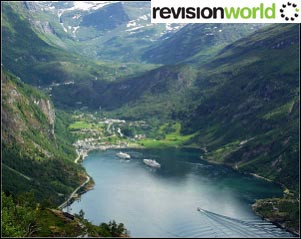Sea Level Changes
Apart from daily and seasonal changes in sea level due to the tides, the average sea level changes long term due to a variety of factors.
During the last ice-age, water was held back from re-entering the oceans as it remained frozen on the land.
This eustatic fall in sea level resulted in a drop of between 100- 150 metres compared to present sea level.
At the same time, the great weight of ice that accumulated (many kilometres thick in places) was sufficient to depress parts of the earths crust leading to an isostatic change in sea level.
After the ice age, there was a relatively rapid eustatic rise in sea level as the ice melted and water returned to the oceans.
It has, however, already taken at least 10,000 years for the land to very slowly rise again as the weight of the ice was removed.
Thus the isostatic readjustment is still going on in areas such as Norway and Scotland (4-20mm per year).
Other causes of sea level change include:
- tectonic uplift of new mountain ranges
- tectonic tilting of the land
- local earthquake and volcanic activity
Changes in sea level lead to distinctive coastal scenery and landforms.
Submergence of the coastline leads to the drowning of many low-lying coastal areas.
Many river estuaries have been formed or enlarged by submergence.
Rias are the drowned lower portions of river valleys. Many have only small rivers or streams flowing into large, deep estuaries. These form excellent natural harbours and are a common landform in south-west England.
Fjords are the drowned lower portions of glaciated valleys. They are broader and deeper than rias and have very steep sides. They are a common landform along the coast of Norway.

A dalmation coastline is formed where the geology creates valleys parallel to the coast so that when sea level rises, a series of elongated islands remain offshore.
